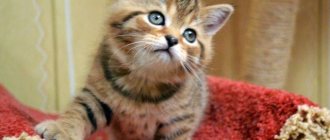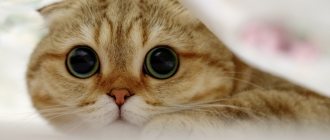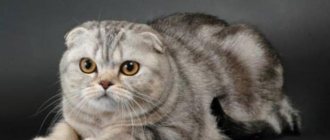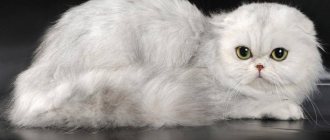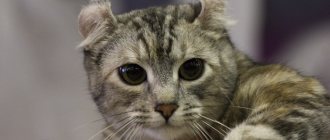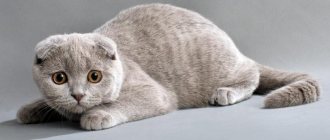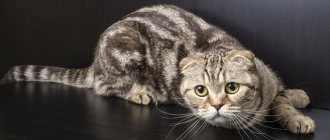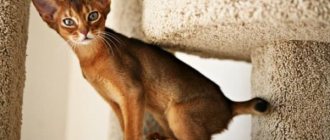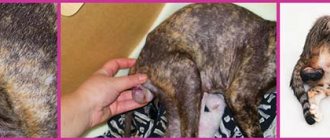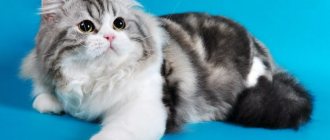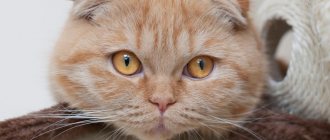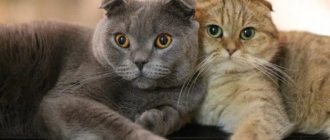Video
* We invite you to watch a video about the Scottish Fold cat . In fact, in front of you is a playlist in which you can select and watch any of 20 videos about a given cat breed by simply clicking on the button in the upper right corner of the window. In addition, the material contains quite a lot of photos. By looking at them you can find out what a Scottish Fold cat looks like.
In this article:
|
Rate the material!
[Total votes: 5 Average: 4.2]
The Scottish Fold cat , or as this breed is called throughout the world - Scottish Fold - is an unusual breed of cat with a certain structure of the ears. These cats' ears are slightly curved down and forward, which makes kittens of this breed look like little bear cubs or owls. The reason for this unusual appearance for cats is a gene mutation.
Origin of the breed
Initial information about cats with drooping ears dates back to the literature of the East of the 19th century. But such animals did not interest cat lovers in China, so they did not become popular there.
But such animals became famous in Scotland in 1961. They owe this to William Ross. He found a light-colored female, whom he named Susie. It happened on farmland near the town of Cupar Angus in the district of Teysand. Such cats owe their unusual appearance, bent envelope and ears flattened to the head, to the inheritance of this ear deformity.
Scottish Folds were created as a breed with the help of closely related British and American short-haired females. Some kittens came out with droopy ears, while others were straight-eared.
After a couple of generations of Susie's cubs, the Ross couple tried to submit the new breed for formal registration.
But not every world organization of felinologists accepted the phenomenon of Scottish Folds with enthusiasm. For example, the British world association FIFE still does not consider Scottish Folds a breed due to genetically mutated ears (photo of the British Fold cat can be seen here).
Another organization in England initially accepted the breed, but later began to reject individuals with flat ears, considering the main characteristic a deviation and prohibiting the selection of these cats.
But other clubs of cat lovers, CFA and WCF, recognized Scottish Fold cats as a test breed in 1974, and four years later, at an elite exhibition in the United States, Scottish Folds earned rave reviews from felinologists and fans.
Since that time, these charming cats have turned into full-fledged competitors in various international cat shows.
History of the origin of Scottish Fold cats
The Scottish Fold breed appeared relatively recently, about 50 years ago. The ancestors and main relatives of Scottish Fold cats are British Shorthair cats. Despite the fact that the ancestors of animals of this breed were short-haired, the first kittens of this breed had mostly long hair. The first kitten known to the world was bought by Valery Ross in 1961 on a farm in the Scottish city of Tayside.
The kitten was unique in its own way; it had unusual ears that hung forward. The kitten's mother, the cat Susie, was the very first representative of this breed and gave such beautiful offspring. In 1973, kittens of this breed went to the famous cat breeder Sally Wolfe Peters, and this breed attracted public attention.
In 1978, cats of the Scottish breed participated in cat shows and received the status of the Cat Fanciers' Association. More and more people wanted to get such cute pets, however, for a long time they did not dare to breed cats of this breed in nurseries, and even a ban was introduced on the breeding of cats of this breed. This prohibition is due to the fact that if you cross a cat and a cat of the fold breed, offspring will be born with disorders in the musculoskeletal system.
Such animals cannot live a full life. The breed can only exist by crossing lop-eared individuals with individuals with straight ears. When these recommendations are followed, healthy fold-eared offspring are born. In 1993, the CFA adopted a standard corresponding to this breed.
Scottish Fold cat - description of the breed
Scottish cats come in several types:
- Scottish Straight (short-haired fold);
- Helend-fold (long-haired fold);
- Hayland Straight (long-haired straight).
Fold cats have a powerful body with developed and strong muscles. The animal's height is 24-25 cm and its weight is about 4.5 kg. The head is round, large round eyes are set wide apart. The iris of the eyes is most often amber-yellow, but can also match the color of the cat. The animal's face has particularly pronounced chubby cheeks and a well-developed chin. The whisker pads are round. The neck is powerful. The cat's paws are short but powerful. The chest is large and voluminous. Shoulders and hips are the same size and shape.
A special feature of cats of this breed are neat small triangular ears curved forward. Due to the unusual crease of the cartilage, the ears are pressed tightly to the head, and the tips of the ears are directed forward and downward. By the way, small kittens of this breed are born with straight ears, but by the end of the first month of life, the kittens’ ears begin to “sag,” and over time they bend, almost completely pressing against the skull.
The Scots have a long tail, slightly tapered at the end. Animals with a movable tail are especially valued due to the fact that this breed often has mutations that lead to diseases of the musculoskeletal system; when purchasing, they always look at the mobility of the tail. The fluffiness of the tail also affects it; previously, a fluffy and beautiful tail was considered a cat’s real asset, until it turned out that such a fluffy tail interferes with the animal’s movement.
Now the fluffy tail of a fold-eared cat is a reason for disqualification from a cat show. The animal's fur is soft, plush with a rather thick undercoat. The color of the animal may vary. The average lifespan of Scottish Fold cats is 10-15 years, however, there are individuals that live up to 20 years.
Popular colors of Scottish Fold cats
The color of Scottish cats can vary.
The most common types of colors are:
- Solid solid colors;
- Bicolors;
- Tortoiseshell colors;
- Tabby color;
- Calico color;
- Chinchilla color;
- Harlequin color;
- Color van;
- Shaded color;
- Tacked color.
Solid color means the absence of any inclusions of another color. If there are hairs of a different color, this is either a color defect or a color of a different type. Solid colors are: blue, ebony, chocolate, fawn, lilac, cream, red.
Bicolor is a color that contains white in addition to the main color. In this case, the upper half of the animal is often painted in one color, and the abdomen, lower part of the muzzle and the tips of the paws are white. Ideally, the designs should be symmetrical.
Point. A color in which there is a basic light tone throughout the body, and a darker coat color on the face, paws and tail. Point-colored cats have a gene that causes the fur to darken in those parts of the body where the body temperature is lower due to poor blood circulation.
The tortoiseshell color is distinguished by the presence of dark spots and spots of red color. It should be noted that tortoiseshell colors are found only in cats; if such a color is seen in a cat, this indicates a genetic mutation in which the animal cannot bear offspring.
Tabby color. Cats with brindle, spotted or marbled color.
Shaded color - colors in which the main part of the hair is white, and only the upper part of the hairs is colored a different color.
Wang. Van cats are white, but the tail and face are a different color.
Harlequin. The Harlequin color is characterized by the fact that against a general white background there are spots of other colors.
Breeders value Scottish fold cats of tortoiseshell color, since such a cat is a carrier of the genes of the black and red series. Although all the colors of the Scots are especially beautiful.
Character and habits of the Scottish Fold
Scottish Folds are simply created for life in a large family. They are very sociable and playful. They love to involve all family members in their games. Scottish cats are very sociable and get along well with children and the elderly. They allow children to cuddle themselves and play with them with pleasure. As for the character of each individual, like people, it is individual; some associate the color of an animal with certain character traits.
For example, it is believed that blue Scots, due to their British genes, have a more quarrelsome character, and on the contrary, bicolors are considered cats with a soft and good-natured character. However, each animal is individual in one way or another. Some Scots do not leave the hands of the owner and strive to be close to the owner, while others, on the contrary, do not let anyone near them.
Interesting fact: Handsome adult lop-eared cats can easily tolerate loneliness and can sleep all day or occupy themselves on their own. However, if the animal wants attention or gets hungry, it will definitely let you know about it with its loud “meow”.
The Scots also have such character traits as stubbornness and willfulness. Often expressed in whims and a desire to be the center of attention. Although these cats can be trained well. At the genetic level, cats of this breed have certain beautiful manners. The Scots are well accustomed to the litter box, they recognize the scratching post and do not damage the furniture; they behave quite decently and decently.
Even if the cat is offended by something, he will not take revenge. The Scots never steal food, they can eat from the table or from the pots, but they never hide, but eat calmly and openly, with the dignity of kings.
Character of Scottish Fields
When getting a Scottish Fold, you shouldn’t expect him to be as soft and plush on the inside as he is on the outside. The Scotsman is a rather capricious animal that knows its own worth and, if necessary, can stand up for itself.
These are very loyal cats that become attached to their family members. But don't expect him to spend time on your lap. He would rather sit next to you like a dog. It also cannot be said that they do not like affection. They love it very much! But only when they themselves want it.
A fold-eared cat meows very rarely, and then only when it considers its appeal to the owner necessary and important. And even then her voice is not loud at all and a little raspy. Fold cats inherited this quality from the British.
The instincts of the Scots are quite well developed and you can try to accustom them to anything.
They won't remember many commands. And if they do something, then only if it arouses their genuine interest.
Often these cats can be found performing yoga exercises, and their yoga is completely exclusive. Scots can adopt a meditation pose with their paws stretched out in front or spread out on the ground, pretending to be a rug. They can often be seen standing on two legs, like a chipmunk, with their head tilted to the side in curiosity.
The Scots simply love various games. You can attract their attention with both complex puzzles and simple teasers.
Scottish Folds quickly get used to unfamiliar animals and do not create conflict situations. They behave very calmly in unfamiliar places; the word “panic” is simply not familiar to them. Therefore, at exhibitions they are simply an example of calm.
The Scottish Fold is a sociable animal, you can always count on his company. He will even watch the series with you on a winter evening, but, however, it is unlikely that he will be able to share his impressions of watching it.
Interesting facts about Scottish Fold cats
The first fold-eared cats appeared completely by accident due to a genetic mutation; later people fixed this gene artificially. Fold-eared cats cannot have healthy offspring within their breed; when crossing a fold-eared cat with a fold-eared cat, kittens with diseases of the musculoskeletal system are born, therefore, to obtain healthy offspring, fold-eared cats are crossed with straight-eared cats.
Scottish cats can come in a variety of colors. For a long time, there was a ban on breeding cats of this breed all over the world, but after breeders learned how to correctly cross fold-eared cats with straight-eared cats, it became allowed to breed cats of these breeds in nurseries. One litter usually produces 4 kittens.
It has been noticed that Scottish cats love to stand on their hind legs and stand in the gopher pose for a long time. Scottish Fold cats do not like heights, so with a cat of this breed you don’t have to worry about chandeliers and high shelves. The cat definitely won't go there.
Scottish cats are very smiling - this facial expression is obtained due to the rounded convex cheeks and the round shape of the head. The Scottish Fold cat has an unusual, peculiar, hoarse voice. Small fold-eared kittens are born with straight ears, and only by the time the kittens are a month old do the ears begin to sag a little.
By the age of four months, kittens have a dense undercoat, their ears become tightly pressed to their heads, that is, the kittens become similar to their parents. Remember the Soviet cartoon “Kid and Carlson”? The famous and lazy cat Matilda is the first representative of the Scottish Fold breed to appear on Russian screens.
Unique characteristics of the breed
Owners of Scottish Folds share their observations. For example, some Scottish women love to dream with their paws stretched out in front of them.
Surprisingly, these cats are unique in that they can easily sleep on their backs. Standing at attention on its hind legs, when the cat begins to resemble a gopher, is characteristic only of the Scottish Fold.
Owners also testify that their pets love massage done with a comb. It is noteworthy that they are not averse to being combed either lengthwise or against their fur.
Basically, owners of Scottish Folds are unanimous in their opinion that cats of this breed are excellent pets. They are gentle, intelligent, and easy to train. Well, their unique exterior invariably touches everyone.
Scottish Folds have the only serious drawback - hereditary diseases. If chondroosteodystrophy or hemophilia is detected, specialists prescribe a course of relief from symptoms. Those animals that are lucky enough to avoid genetic diseases enjoy good health.
This is interesting - the most popular cat breeds with pictures.
Popular kennels for this breed:
- Russia - (your nursery is here);
- Belarus - (take place);
- Ukraine - (submit an application).
Pros and cons of Scottish Fold cats
The main advantages of these cute cats include the following qualities:
- Kindness. It’s difficult to piss off a Scot, but it’s still possible;
- Good attitude towards children;
- Sociability and cheerful disposition;
- Dignified, almost aristocratic behavior;
- Lack of touchiness. Even if you offend the cat, he will not do anything dirty in revenge;
- Mind. Scottish Fold cats are quite smart cats, they quickly get used to the tray and scratching post, and respond well to the calm words of the owner. If a Scottish Fold cat does not obey its owner, it means that the cat most likely does not like the way he is being treated;
- They get along calmly with other pets and do not share territory even when they are close to cats. He can even be friends with a dog if he treats the cat well;
- Despite their good disposition, Scottish cats are still predators, and they are excellent at catching mice and sometimes birds.
There are disadvantages to cats of this breed and they cannot be ignored:
- Cats of this breed must be brushed at least a couple of times a week in order to remove dead hair and massage the animal’s skin;
- Scottish Fold cats are simply extremely inquisitive. They love to watch what the owner is doing and climb into all secluded places;
- Sometimes there is excessive affection, but it all depends on the individual characteristics of the animal. Plus, Scottish Folds don’t particularly like guests and treat new people in the house with caution, although they behave quite decently;
- Scottish cats often love to lick themselves, and during licking, hair gets into the animal's body, so cats of this breed must be fed with special food to remove hair from the stomach.
Special habits of the Scots
Scottish Fold
Description of the character of the Scottish Fold cat can be described by their characteristic habits:
- Interesting and even funny leisure habits. They sleep on their backs, which is not typical for cats in principle. This sleeping position is not observed in any other breed of cat.
- Observing something while standing on its hind legs if the object is high.
- To attract attention and receive its share of affection, it can purr and rub its muzzle against a person.
- Can't stand being held or being squeezed. The cat may show its displeasure.
- In pursuit of an object of interest to them, for example, when playing with a person, they run very fast and can climb onto a hill. They jump well, run and have well-developed muscles.
- Scottish cats are usually silent. They voice only in important situations, in their own opinion. If you come across a sociable individual, you need to understand that he will become too sociable. He will accompany with his comments every step of the owner and his own. Many people don't like this behavior. Therefore, it is worth taking a closer look at the animal’s character while still in the nursery.
How can you recognize the character and disposition of a kitten from childhood? All kittens, due to their age, are active and curious. Any rustle in the apartment arouses their attention and interest. It’s difficult to see a small kitten doing nothing; they are constantly busy with something and find new things to do. If there is no toy, it will be replaced by any object that comes into the animal’s field of vision. The toy can even be an object imagined in the kitten’s fantasy or a play partner.
But there are kids who prefer to sit on the sidelines and not participate in these races; they play with their brothers reluctantly and rarely. This behavior is considered normal for this breed. Such individuals are considered less active, cautious, and calm. Such kittens spend time alone, exploring the surrounding space in a measured manner. It has been noticed that such animals are more devoted to their owners.
The letter M on the forehead of a Scottish cat
Good nature and sociability
The Scottish Fold cat breed can be called a model of behavior. They are reserved, well-mannered, and are not inclined to impose their company on a person. But the breed has a pronounced good nature and good sociability. This applies to people and animals. They are not distinguished by vindictiveness, which is observed in other cat breeds. Conflict situations for fold-eared and straight-eared cats are a rare situation in which the cat showed protective measures in response to aggression towards him. If you offend a Scottish dog, he will prefer to hide rather than get into a fight. This is a last resort for them.
How to express your desires
Scots express their desire for something with a special purr, a voice that is unique to this breed. They can rub their muzzle against a person, follow him, and try in every possible way to get attention. They exhibit this behavior in cases of hunger, the need to play, and other situations that they consider important.
Interesting read: who are the lop-eared Britons?
Activity
The character of the Scottish Straight cat is phlegmatic. Their movements are measured and unhurried. They rarely run, especially in adulthood. If an adult cat is asked to run after a candy wrapper or a string with a piece of paper, the cat will express its bewilderment and surprise. The best pastime for them is to lie on their bed and take a nap.
Cleanliness
This breed is considered clean. They love to take care of themselves and maintain hygiene. They can spend hours licking their fur. Some owners say that sometimes this ritual is similar to mania, and a person’s touching them is regarded as an encroachment on his freedom. This character trait also applies to the toilet. They should always have a clean tray, but it is not typical for the animal to miss it. Going to other places to relieve yourself is a crime and an extreme rarity for the Scots.
Breeding Scottish Fold cats
Breeding Scottish cats is a very complex process since these cats have problematic genes, the manifestation of the negative consequences of these genes can only be avoided by selecting a pair. By the way, it’s exactly the same story with Munchkin cats. Fold-eared cats are never bred with a fold-eared partner, since in this case offspring are born with serious genetic diseases of the musculoskeletal system. Cats of the Scottish Fold and Highland Fold breeds are crossed exclusively with the straight-eared Scottish Straight and Highland Straight, only with such mating the offspring are born healthy.
Cats are ready for mating at the age of one and a half years. You cannot breed cats during their first heat; you must wait until the second, or better yet, the third. It is also worth remembering that a cat can become pregnant on the second or third day of estrus. The first mating process is quite complicated, and nature does not always tell cats what to do. If the cat has not interacted with her own kind before, the process of the first mating can be very complicated. In this case, cats begin to show aggression towards their partner, hissing and growling menacingly.
Even if the cat behaves calmly, she can simply lie on her side and not let the cat near her. Mating of Scottish cats should always take place in the male's territory. In this case, the male feels completely safe and can spend all his energy courting the cat. The cat's owners are only required to correctly calculate the day when to produce it, and provide the cat with its usual food and litter tray for the mating period.
Mating usually takes 2-3 days. On the first day, the animals get to know each other, adapt and form sympathy. Mating occurs on 2-3 days. During the mating period, cat owners must allocate a separate room for the cats, where no one will disturb them, and the area must be closed so that the guest cannot escape. Cat mating games go something like this: the male settles down at a short distance from the cat and does not show any attention, sometimes he comes closer to the female, but she scares him off with a menacing hiss.
Later, the cat pretends to be asleep and doesn’t care about the female at all. Discouraged by the lack of attention, the cat begins to roll on the floor and meow, calling for a male. When the cat begins to show interest, the cat becomes aggressive again. This is repeated over and over again until the cat gets bored and stops resisting. Sexual intercourse in cats lasts about 5-10 seconds. About 10-16 matings occur within a few days.
The main signs of pregnancy in a cat:
- Morning sickness;
- The cat's nipples become swollen;
- The cat's appetite increases greatly;
- Character changes;
- The animal becomes more nervous;
- The cat may be aggressive;
- At the end of the second week of pregnancy, the fetuses can be felt by palpation;
- A cat's pregnant belly appears towards the end of the 6th week of pregnancy.
Pregnancy in Scottish cats lasts approximately 9 weeks. One litter usually produces 4 kittens.
Varieties of Scots
Scottish cats with drooping ears, Scottish Fold, are one of the categories of cats with short hair and folded ears. Scottish Straight, Scottish Straight, is a breed subspecies, individuals of which have fairly short fur and protruding ears.
Long-haired (Highland) Fold Scots have luxurious fur and flat ears. Long-haired straight-eared cats have long fur and erect ears.
Caring for Scottish Fold cats
Folds are quite unpretentious by nature. But do not forget that they are very inquisitive, they love to climb into various secluded places, play with wires and cables that they can chew. They might get stuck somewhere or fall out of a window. Therefore, before bringing a kitten into the house, it is better to prepare a little.
Hide all wires and chargers, put valuables away. The animal should prepare a sleeping place, a place for food with several bowls and a tray with filler. Little kittens are very playful, so to prevent the kitten from getting bored, it is better to purchase special toys. Pay special attention to caring for your pet's coat.
Interesting fact: The Scotsman needs to be brushed once a week with a special soft comb. At the same time, you should not use a slicker because it can damage the delicate undercoat. If the cat does not go outside but lives in an apartment, bathing it once every six months is enough.
After bathing, the kitten should be wrapped in a soft towel, and then the fur should be dried thoroughly so that the kitten does not catch a cold. Once a month, trim the tips of the animal’s claws with special scissors; this must be done carefully so as not to cause pain to the cat. You should also clean your pet’s ears every few weeks. This is done with a cotton swab.
Scottish cats have an excellent appetite and are prone to obesity, so try to choose a balanced diet without overfeeding the animal. Kittens should be trained from the first days the animal appears in the house. The kitten must immediately be accustomed to the tray, scratching post, and sleeping place.
It is necessary to immediately stop negative actions, otherwise it will be almost impossible to wean the kitten later. Folds have an extraordinary mind and good manners from birth, so raising these cats is quite easy for the owners of these pets.
Catering
You can choose to feed your pet: natural food or industrial ready-made food. But it is not recommended to mix one with the other: different enzymes are produced for processing different types of feed, and by complicating the process, you unnecessarily burden the stomach.
Natural products
From natural food you can give:
- Pre-frozen lean meat: veal, beef, turkey, rabbit, lamb, chicken. When cooking, some of the beneficial substances are destroyed, so processing should be minimal. Be sure to pour boiling water over raw meat before serving: this procedure will destroy parasites and their larvae and eggs.
- Fish: trout, hake, salmon, flounder, tuna, navaga. But not more than once a week (excess fish provokes the development of urolithiasis.
- Dairy products: unsalted hard cheese, low-fat cottage cheese, natural yogurt without additives, sour cream, fermented baked milk, yogurt, Varenets.
- Boiled chicken yolk, boiled quail eggs.
- Porridge: rice, millet, buckwheat, oatmeal, pearl barley, semolina. Porridge is cooked in water without sugar, salt or seasonings, adding a little bit of any vegetable oil (half a teaspoon of olive, flaxseed, sunflower).
- Vegetables: broccoli, zucchini, carrots, pumpkin, asparagus, green beans, celery. As a treat: watermelons, melons, cucumbers, apples.
A separate bowl should always contain clean water at a comfortable drinking temperature. Do not feed your cat directly from the tap: tap water is too hard, saturated with salts, bleach and other components dangerous to the animal.
You cannot give:
- fatty, smoked, salty, sweet, sour, spicy, pickled;
- alcohol, compotes, juices, mineral water, tea, coffee;
- dog food;
- human canned food;
- products containing cocoa, seasonings, spices, ketchups;
- eggplant, avocado, onion, garlic, raisins, legumes.
Recommended food
Among ready-made foods, it is better to give preference to holistic foods AATU, Applaws, Canagan, Natural and super-premium Leonardo, Mealfeel, Meowing Heads. Premium and economy class food is made from low quality products, their composition is poor, there are no vitamins and minerals, but there is an abundance of dyes and questionable components.
Below are recommended super-premium foods. Links with the names of the food are clickable, on them you can, within our website, get acquainted with the descriptions of the food and read reviews from owners of Scottish Fold cats.
| Holistic | Super premium | Super premium |
| Acana | Karmy | Landor |
Diet of Scottish Fold cats
A cat's diet should be varied and include all the necessary vitamins and microelements that the animal needs. For Scots, premium food is usually used, alternating dry food with canned food. Since hair constantly gets into the animal’s body when licking, it is better to give preference to foods that cleanse the cat’s stomach of hair.
In addition, it is good to feed the animal with natural products such as:
- Boiled lean meat (veal, beef, chicken, pork);
- By-products (liver, spleen, lungs, kidneys);
- Boiled fish of low-fat varieties;
- Quail eggs or chicken egg yolks;
- Cheese, fermented milk products (kefir, sour cream, yogurt, etc.);
- Boiled vegetables.
Under no circumstances should cats be given smoked meats and salted fish; cats’ livers cannot cope with such heavy food. Since pets of this breed are prone to obesity, it is better not to overfeed them. In addition to food, you should ensure that the animal always has clean water in its bowl. The remains of uneaten food should be removed and the bowls should be washed well so that the cat does not get poisoned by spoiled food.
For pregnant cats, portions should be increased; it is advisable to add special vitamin complexes and calcium to the food, which can be purchased at a veterinary pharmacy. Neutered Scots are more prone to obesity than cats of other breeds, so it is better to feed them with special light, balanced food for neutered cats.
Care instructions
Thick fur requires regular brushing: once a week or 3 times a week (during shedding). It is enough to buy a regular brush: with natural hard bristles. Since animals swallow fur when licking themselves, you need to help them remove it. To do this, you can grow special grass (sold in pet stores) or give a paste for lumps in the stomach.
Bathing
Scottish Folds usually do not mind bathing. You should not bathe your cat more than once every 2-3 months, so as not to wash off the protective layer from the skin once again. But this must be done before the exhibition. Use special cat shampoo: it will not cause an allergic reaction and will not poison your pet.
Does your cat like to swim?
Not really
Ears
Ears are examined and cleaned once a week. Due to the specific structure of the auricle, wax and dirt quickly accumulate there, so you cannot do without a special cleaning lotion. It can be purchased at a veterinary pharmacy.
Do not put liquid or ointment into your ears without your doctor's permission. This provokes otitis media!
Claws
If your Scottish Fold grinds its claws down on its own, all you need to do is buy a quality scratching post. Otherwise, you will have to trim your cat's claws weekly using a nail clipper or regular nail scissors. Be careful not to touch large vessels.
Teeth
Teeth are brushed once every 2 weeks using cat toothpaste and a small toothbrush (you can adapt a regular baby brush by shortening its bristles).
A Scottish Fold kitten costs from 15 to 60 thousand rubles. The price depends on the class (pet, breed, show), appearance.
Diseases and health problems
Due to the fact that this breed was created by nature due to a genetic mutation, Scottish Folds may suffer from genetic diseases such as osteochondropathy. This is a hereditary congenital disease that can be fatal to the animal.
These cats may also suffer from other congenital diseases such as arthritis, chondrodystrophy, arthrosis. These diseases are most often the cause of incorrect crossing of lop-eared and straight-eared pets. Therefore, when buying a kitten, you need to pay special attention to the kitten’s movements, gait, and tail movement.
Due to the unusual shape of the eyes, Scots often suffer from entropion, and the animal requires surgical intervention. Older cats may develop cataracts or glaucoma.
Important fact: Some cats may be allergic to certain types of food, so if you notice that your cat is itching and acting strange, it is best to take the animal to the vet.
Older cats may suffer from diseases of the cardiovascular system, stomach and liver problems may occur, so once a year the animal must be shown to a veterinarian. Through contact with other animals, a cat can also become infected with various parasitic diseases. Therefore, it is always necessary to take preventive measures and avoid contact with carriers of parasites.
Health
Due to the presence of a gene that helped the Scot acquire cute ears, he developed a tendency to arthritis and arthrosis, which are very common.
Scottish Folds are also prone to cardiomyopathy.
The special shape of the animal's eyes allows fur to get into the eyes. They may become inflamed.
It is also known that due to problems with cartilage, these plush beauties experience pain in the spine. That's why they sit with their backs pressed against a support or take a gopher pose with their paws pressed to their chest. This helps them relieve tension from their back.
